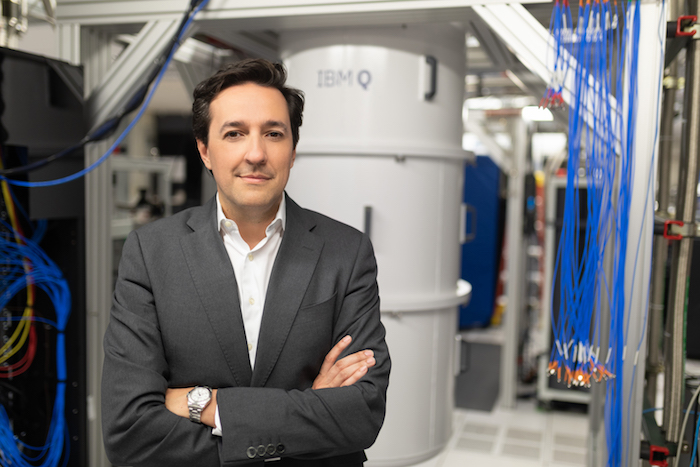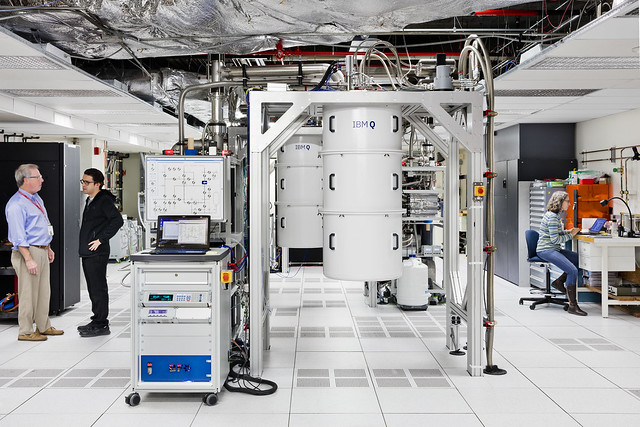Gauging progress in quantum computing is a tricky thing. IBM yesterday announced the opening of the IBM Quantum Computing Center in New York, with five 20-qubit systems up and running and a 53-qubit system expected to go online next month. The latter will become “the largest universal [gate based] quantum system made available for external access in the industry,” says IBM. New additions, including the 53-qubit system, will bring the IBM fleet of commercially available quantum computers to 14 by year’s end according to IBM.
Actually, the new “center” encompasses two locations, Poughkeepsie and York Town, with the following systems: Poughkeepsie has two 20-qubit systems, three 5-qubit systems, and will host the 53-qubit machine; Yorktown has three 20-qubit systems, one 5-qubit system, and one 14-qubit system. IBM isn’t releasing details on the other three systems soon to be made available.
What’s interesting here, besides introduction of the new 53-qubit system, is that IBM director of research Dario Gil says demand for access to quantum systems is what’s been driving IBM’s rapid expansion of its fleet. Just last week, IBM announced a collaboration leading European research organization Fraunhofer-Gesellschaft in which a new IBM Q System One, owned and operated by IBM, will be located in an IBM facility in Germany. IBM reports on the order of 150,000 registered users for its quantum systems.
More qubits. More Machines. All chasing something called quantum advantage which IBM labels as the “single goal” of the quantum community. That sounds like clear progress and it is. However, progress, even steady progress, is one thing, but payoff is another.

IBM, to its credit, has tended to limit its contribution to the hype surrounding quantum computing. Gil, who moved into the IBM Research director role this year, briefed HPCwire on the IBM news and also touched on Big Blue’s overall strategy, the Quantum Volume benchmark pitched by IBM, and a few technology issues being tackled – for example, IBM uses a variety of quantum processor topologies in its systems seeking to identify which topologies work best for particular use cases.
He also injected a note of realism. Asked to define quantum advantage and forecast when it would be achieved, Gil said, “We define QA as when we will have systems that are powerful enough, and, of course, programmable, that would allow us to solve problems that matter, right, something of relevance to your business or science that we couldn’t do before. So my best estimate is that we’re still years away.”
Quantum industry watcher Bob Sorensen, VP of research and technology and chief quantum computing analyst, Hyperion Research, offered praise and caution:
“IBM is demonstrating its long-term commitment to developing quantum computers for the commercial sector and is working hard to roll out a continual steam of tangible gains in technology. But, perhaps more important is IBM’s recent announcement that the firm will install a Q System One quantum computer at one of its facilities in Germany as part of a two-year partnership with the Fraunhofer Society to build a research unit and community around the system. To me, such a deal validates that IBM is not just building systems and hoping to attract customers but instead is working to establish a complete QC ecosystem that spans hardware, software, applications and real world use cases.
“My major concern with the sector right now is that a seemingly steady stream of announcements across the broader QC supply base citing increasing qubit counts, or related metrics, may soon trigger a ‘breakthrough fatigue’, garnering less and less public attention. Strong interest, within both the government and commercial sectors, needs to be maintained if the QC sector is to stay on a robust virtuous development cycle. As such, the sector needs to start rolling out demonstrated quantum advances that translate into real-world application success. I am hoping (perhaps even expecting) some significant developments there in the short-term.”

IBM reports its IBM Q Network program now supports “nearly 80 commercial clients, academic institutions and research laboratories to explore and develop quantum computing algorithms.” IBM offered the following examples progress in its recent announcement:
- “J.P. Morgan Chase and IBM published a methodology to price financial options and portfolios of such options, on a gate-based quantum computer. This resulted in an algorithm that provides a quadratic speedup, i.e. whereby classically computers need millions of samples, our methodology requires only a few thousands of samples to achieve the same result, when comparing to classical Monte Carlo methods. This may allow financial analysts to perform the option pricing and risk analysis in near real time. The implementation is available as open source in Qiskit Finance.
- Mitsubishi Chemical, Keio University and IBM simulated the initial steps of the reaction mechanism between lithium and oxygen in lithium-air batteries. Published on arXiv, Computational Investigations of the Lithium Superoxide Dimer Rearrangement on Noisy Quantum Devices, is a first step in modeling the entire lithium-oxygen reaction on a quantum computer. Better understanding this interaction could lead to more efficient batteries for mobile devices or automotive vehicles.
- The IBM Q Hub at Keio University, in collaboration with their partners Mizhuo, and Misubishi Financial Group (MUFG) proposed an algorithm that reduces the number of qubits and circuit length of an original methodology proposed by IBM for quantum risk analysis demonstrated in financial applications.”
You may recall IBM pitched QV to the industry last March as a benchmark for assessing and comparing quantum computing platforms. It’s a composite measure combining, among other things, qubit count, error rates, and decoherence times. It’s not yet clear how much uptake the new metric is generating in quantum community but these are still early days.
IBM has said it believes it can double the QV of its machines on roughly yearly basis. Gil said, “Within the 10 systems [now accessible] five of those are 20-qubit systems with the quantum volume of 16.” For most of us it’s not exactly clear what QV 16 mean or even what a range of desirable QV targets would be beyond continued improvement.

Speaking more broadly about IBM’s growing fleet, Gil said “I think what it shows is [our ability] to go from the demonstrations in the laboratory to rolling out system with 95% availability to an entire community. We do a tremendous amount of research and [still] have lots of things that we haven’t talked about or published, and a roadmap of larger systems [with] high performance, all of that stuff. What we’re communicating here, I think is fundamental, this inflection point we saw in the community in last three years, was going from five, six laboratories in the world [that could conduct] multi-qubit experiments to a community of tens of thousands of people who can run experiments.”
Gil outlined IBM’s over quantum strategy like this:
- Lead with bigger and better machines. “We want to have the most advanced systems in the world, right and that’s linked to wanting the highest quantum volume machines produced to date, the number of those machines, and expanding qubit counts like the new 53-qubit system.”
- Build a large community. “This is embodied in two things. There is the open source component, which is Qiskit (IBM’s python-based developer kit), which is the most widely adopted open source environment for programming in quantum. And the IBM Q Experience, which is the mechanism by which people can program and experience the technology and the community
- Maximize value of the network. “This has to do with commercial partners, now including large companies, startups, and universities. It’s about using all of these resources. The purpose is to discover other things that need matter with practical applications.”
No doubt the core ideas are similar across the quantum technology vendor ecosystem but it’s useful to hear them. Gil declined to say too much about the forthcoming 53-qubit system beyond it embodied a number of advances around control electronics, noise reduction, packaging etc.
“These are still transmon-based devices. So that’s in common to all the fleet. From that perspective, we haven’t changed the device. But if you look at everything from the lattice and the topology the quantum processor itself, to a lot of core technology that goes inside in terms of how things get coupled to each other, the packaging, and so on, you know, there’s a lot of change,” said Gil.
“One of the things we do is that we give our community different device topologies, in terms of qubit structure. It is very interesting and an important aspect. The relationship between the device topology, meaning what is the connectivity of the qubits to one another, can have really profound implications on the performance of the system, dealing with things like what’s called a spectator error, right, the unwanted coupling between qubits with one another and algorithmic implementations. So for many of these systems it is not only a question of capacity, but it’s also a variety of approaches.
“That’s very important because as a community we’re still learning what is the right topology and the intersection between error mitigation strategies and circuit implementations and topology. Every time we introduce systems, for any given size system, we also introduce the right topology or what we think is right the right topology at any given time, but expect us to keep changing. For example, even on the 53-qubit system, expect that we will have multiple iterations where we keep upgrading it and changing it. The task ultimately is to continue to increase quantum volume, but also to find the right mapping between topology and algorithms,” said Gil.
Circling back to the question of when quantum computing will start solving practical problems, Gil is realistic and optimistic:
“Recall when the narrative was, Ok, here’s what we’re going to do. We’re going to all work really hard and one day we’re going to have a quantum machine with billions of cubits that will be Nirvana. When that occurs, we know that there is a class of algorithms, a few of them, that would take some exponential time to [run on] classical systems] that will then be used with these alternate quantum machine. Right That was that narrative.
“What have we been advocating and changing that narrative successfully is now, don’t wait for holy grail. That’s not how technology works. What you’ve got to do is go from where we are today, and systematically, create generation after generation of systems to eventually get there. And value is going to be created and accrued along the way. The first value will be at the level of skills, training, intellectual property, the folks are building the first generation of systems. And we all agree that the community is not millions of people, but it’s hundreds of thousands of people who are involved. I don’t know how many startups there are now. Last time I checked it’s like 20 companies trying to build quantum hardware. If I add software now in stock is probably in the triple digits. We’ve seen national networks and quantum all over the world. So value is accruing along the way,” said Gil.
It’s going to be a long ride to QA and practical quantum computing. Perhaps too many of us are like kids in the back of a car on a long journey annoying our parents with chants of “Are we there yet?” half-intended as a real question and half-shouted just to provoke a response.




























































